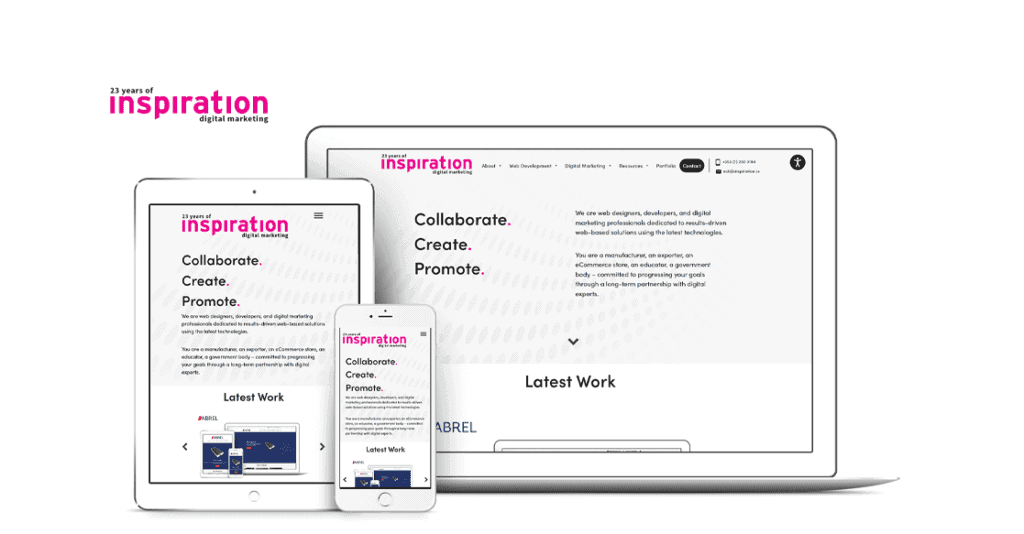
New Site, No Sh*te
Web Development
When you’re in the business of designing and building websites, you often hear new clients say that they’re embarrassed by their current site, and in recent years it’s made me cringe – our own site was more than 4 years old – the cobblers’ shoes were shabby!
To be fair, it’s been a tricky 4 years – we’ve had recruitment challenges, Covid, we shut the office down and transitioned to a virtual team, the dire Ukrainian war is ongoing and now hyper-inflation.
Luckily lots of clients decided to head for the hills in August and there was a window of opportunity – resource finally available to sort the site!
So how does a digital marketing agency go about implementing a web development project and are there lessons for our clients? I think so….
Good Timing, Short Timeframe
The decision on timing was made for us – a developer gave a months’ notice after 3 great years (a lifetime for a dev!) and many clients were off for August – but would be back buzzing with work in Sept. We had 4 weeks flat to design and build the site and we achieved this. Importantly though, we are really happy with the results and don’t feel any compromises were made – the opposite; we went all-out!
So, finding a window where the site can be given the focus it needs works well. Also making the project a Snap event; total focus over a short timeframe – makes it easier to get over the line. Obviously, this will require the assistance of your suppliers – to commit to short timeframes (I feel obliged at this point to say – we’re up for it ????)
On a side-note – recruiting developers has traditionally been a nightmare for digital marketing agencies but within 2 days of advertising for this role, we had 157 applicants (ignoring the ones dis-carded automatically by LinkedIn). And within 2 weeks we had a new recruit. Why? Because it’s fully remote.


No Need to Re-invent the Shoe
Website Design
The first thing we did was to get everyone on the team to find relevant sites they liked. Here we struck gold – it’s unfortunate that for many of our clients, competitor sites are pretty poor. When you’re in this biz, the opposite is true. Try looking outside of Ireland and the UK.
Our designer found 2 US agency sites that we loved, and the website design was inspired by a combination of these two. This didn’t just save a lot of design time; it saved dev time too as the developers could see what plug-ins were being used and how to re-engineer the coding etc.
So don’t just look at local or UK competitors; try further afield for great ideas. Also, while its good to take on board the teams views, someone within the organisation needs to drive the way forward – a benign dictator. Website design by consensus not only wastes time, it doesn’t work! Appoint a Project Champion with full authority.
Cobbling it All Together
Website Development Strategy
Before a thing is built, here’s the skillsets that need to be involved – typically each is a different person – project manager, designer, developer, writer, google expert (search engine optimisation), marketeer. Your website development strategy needs to co-ordinate these skills on a timely basis.
The two things that are needed before a site is built are the website design and the site map, or pages on the site. So, you might think the designer and marketeer can work away to finalise these, but it can save a lot of time by involving all these skillsets early on. You don’t want to design something the developer can’t build. And with the site map; find out how many searches there are for different relevant terms before deciding what to call each section of your site.
For example, there are many more searches for Digital Marketing than for Online Marketing – use research to optimise the right terminology at the outset. The content writers will need to know what terms you are targeting too so they integrate these naturally into the text. The marketeer or commercial resource needs to work with the designer to make sure the User Experience is great and that the main calls-to-action are integrated effectively into the design. If you want a telephone call, don’t hide the phone number on the contact page (and do if you don’t!)
Close teamwork is essential from the get-go. We are lucky obviously to have all these skillsets internally but usually this would include both internal and external resources so you might need to put extra effort in to pull everyone together.


The Perfect Fit for Inspiration
Why did we like those two US sites so much btw? I’ve been thinking about that and there were a few reasons. They were visually high-impact, and our talented designer was able to mash together the best of both aesthetics to make the website design our own – we loved the look she developed.
You can see the overall approach on our homepage. They used complicated animations which both brought life to the site and allowed us to effectively demo our advanced web development technical skills. You can see this throughout the site. For example, in our Projects section, each one has a scrolling demo of the site; here’s an example INSS.
In terms of messaging and content, these companies sold the same services too, but the writing was really fresh; maybe written comms, are just more casual in the US and (forgive me) – cool? It was useful to see how they phrased things in a very direct, energetic manner and we took this style on board but obviously diluted it slightly for a European audience, who prefer a softer approach in general.
Overall though, the best thing about finding approaches we all loved was that it energised and motivated the team. We got the job done quickly because the vision – and the end game – were right in front of us. And we all wanted to get there fast.
Upcycle Quality Material
Content Marketing
There were about 280 pages of content that had built up over the years on our old site, committed as we are to content marketing, but there was a lot of shxte that was worn out with time (like myself!). We brought over just about 30 core pages and a small number of blogs.
If you have a lot of old blogs, re-direct these pages to new relevant blogs or current products and services. But first, download the content or get someone to copy and paste the articles into word. They may be outdated now but the best can be re-invented, as a great source of content into the future. Just edit, optimise and re-publish them with a current date – ideal for Google content marketing. With the re-directs process btw, we found it took a good bit of time, between the necessary tech and SEO interventions. So, it’s important to get all over it quickly. It should be completed within 2 weeks of go-live to make sure key pages don’t lose their ranking in Google.
BTW, in terms of developing fresh content, having a reference site with page templates you like, as we did with the US sites, meant that we could see optimal word counts for each section and easily edit old content into bite-sized chunks for the new site, that sat perfectly within the design of the pages. Small para.’s of text were quick and easy to produce.


Think Nike, Not Louboutin!
No site will ever be perfect and anyway it should constantly evolve over time. The website design and web development process needs to produce a site that delivers on your objectives. It’s more important that it does this, than that it is finally “complete” in your eyes before it goes live. So don’t sweat the small stuff and just get it out there. We prioritised the main services we wanted to promo. And the essential content we needed to go live. We went live with no fanfare on 31st August, and we’ve been doing minor tweaks ever since.
So often, I’ve worked with clients who had desperate live sites but left gorgeous dev sites on hold cos they were missing maybe one technical drawing or team imagery etc. Don’t delay folks – just do it!
Anyway, I’m delighted to say the cobbler got her act together, we are dangerous when we’ve got our dancing shoes on and we are ready to hit the dancefloor! Who’s gonna join us?
Cathy


